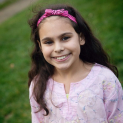B-lapachone as a Novel Targeted Therapy for ATRTs and other Pediatric Cancers
Background
Atypical teratoid rhabdoid tumors (ATRTs) are highly lethal cancers that most commonly occur in the brain of young children. Despite maximally intense therapy, most patients with ATRTs die of their disease and the few children who survive are often significantly disabled due to the effects of radiation on their developing brains. Historically, using targeted therapies for ATRTs has been very difficult as the most common gene mutation in these cancers is not currently druggable.
Recently, our team has invented a series of novel targeted drugs (ß-lapachone and DNQ) that kill cancer cells after being activated by an enzyme (NQO1) that is present at very high levels in many adult cancers. These drugs have now entered clinical trials in adults with cancer.
Project Goal
Recently, we found that NQO1 is very highly expressed in ATRTs and not in the normal brain surrounding the tumor. Thus, this allows targeted therapy for ATRTs. Here we will complete the testing of these drugs for pediatric use. First, we will study a large panel of other pediatric cancers to determine the full extent of cancers that may be susceptible to these drugs. Next, we will confirm that these drugs are effective therapies in cell culture and mice with ATRTs. Finally, we will determine which of these drugs best penetrates into tumors in the brain to allow the selection of the best drug for pediatric patients. At the completion of this grant, we will open a clinical trial of one of these agents in children with ATRTs.
Project Update
We spoke with Dr. Amatruda about his recent REACH Award from ALSF and his work on ATRT.
What has this grant from ALSF allowed you to do that you wouldn’t have been able to do otherwise?
Taking a good idea or a scientific advance and turning it into something that will benefit children with cancer requires lots of different types of skills. We really need a team approach to bring together expertise.
So thanks to ALSF we’ve been able to assemble this combined team at UT Southwestern to test a new approach to treating childhood cancer. I’m working with my colleague Ted Laetsch, an oncologist who is experienced in bringing new treatments to the clinic. Another colleague, Dinesh Rakheja, is a pathologist. David Boothman is a very experienced biochemist who has worked many years on the “Achilles Heel” approach to cancer treatment, developing agents that target vulnerabilities in cancer. These treatments, because they are targeted to the disease at the biological level, should have fewer side effects.
In simple terms, what is this project?
The Boothman lab has pioneered research into beta-lapachone drugs (“beta-lap”) for treating adult cancers. The technical part of that is the NQO1 enzyme, which, when in the presence of this drug, makes two things happen. The first is that the enzyme grabs the compound and tries to detoxify it and in doing so, uses up the energy source of the cell. The second thing is that, while this is happening, the reaction produces hydrogen peroxide as a byproduct. Hydrogen peroxide is the same stuff your mom used to put on your skinned knee to clean it. And the reason she did that is because hydrogen peroxide kills bacteria. But the reason it’s important here is that it also kills the cancer cells, especially cells that contain a lot of NQO1. David has very exciting results using beta lap against breast and pancreatic cancer cells.
So this raises the thought, “Gosh, I wonder if there are any pediatric cancers this applies to?” But nobody knew the answer.
Atypical teratoid rhabdoid tumor (ATRT) is a rare childhood cancer. Nobody knows where it comes from. It appears in the brain, or sometimes in the kidney. But there are no good treatments.
In the case of ATRT, Ted and Dinesh found that the tumors make high levels of the NQO1 enzyme, so we’re excited to see if beta lap works against ATRT cells. What’s great is that the drug is already approved for use in humans, through Dave Boothman’s work. This will make it easier for us to translate any success we have into a real treatment.
What are some of the challenges you’ve faced?
One of the challenges is that some kinds of cell lines, for example, breast cancer cells or pancreatic cancer cells, are happy to grow in the lab, and some cell lines aren’t. Ted [Laetsch] has contacts which have helped us, as we say, “corner the world supply” of cell lines from ATRT. We’ve sent out word that we’re doing this and we’ve gotten the best cell lines so we can really do it well. Dinesh is also a wizard at growing these lines, and has contributed some as well.
What are your next steps?
We’re really early in this process, so now we need to rigorously test our approach. There are lots of beautiful ideas in science that don’t pan out, so the next step is to try this and see how this works out.
What does this mean for children with cancer and their families? Why have you chosen to work on this project?
I’m very excited about this project. Usually it takes years and years before research becomes translated to clinical use. This one has the potential to be really different! The special thing here is that if it works we’ll be able to capitalize on the work that’s already been done to turn it around for pediatric cases right away.
What’s really special about the Reach Award is the chance to take an idea like this and test it and validate it. There’s a need in research for very basic investigation but also things that are ready to go and can move quickly into the clinic. We’re so grateful to ALSF and all of the wonderful people who support it for this fantastic support.

